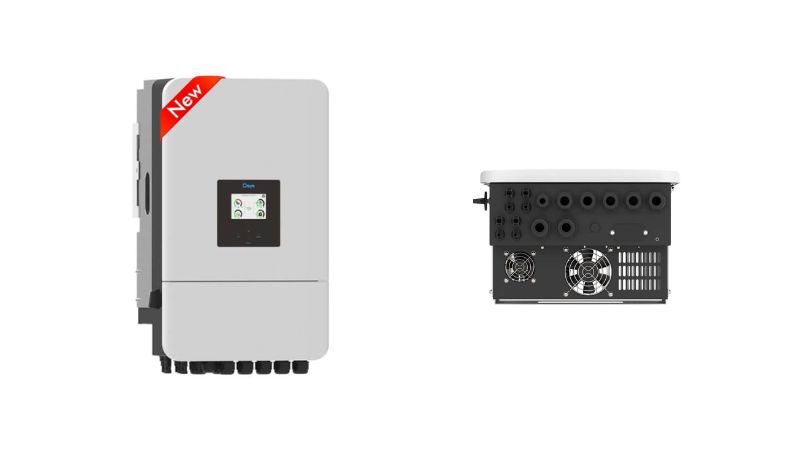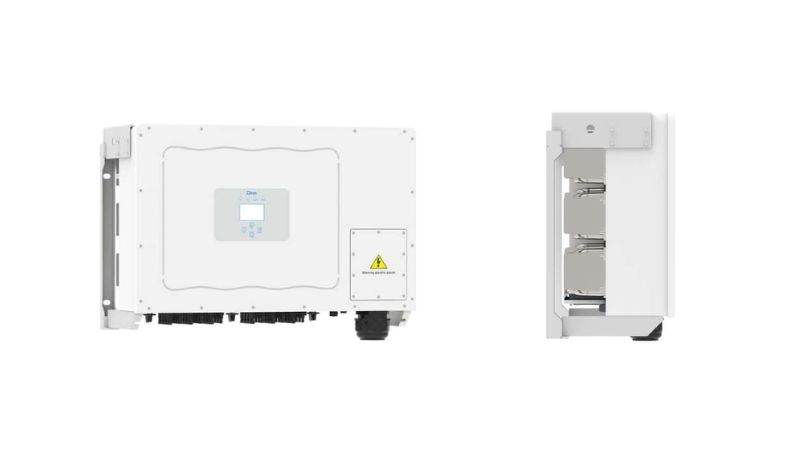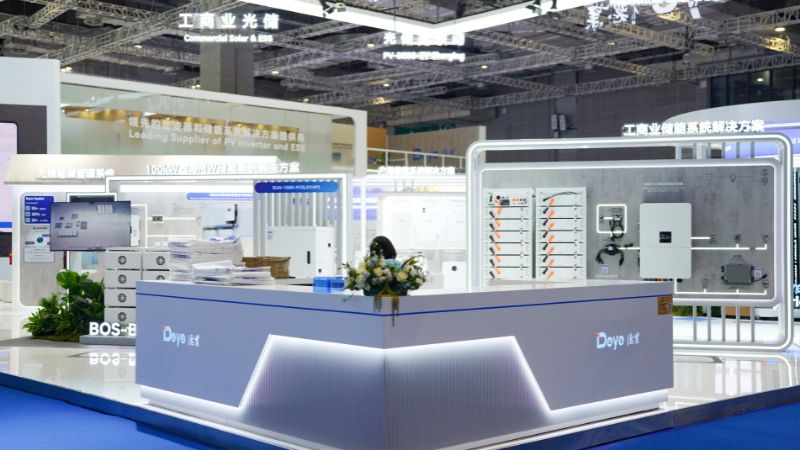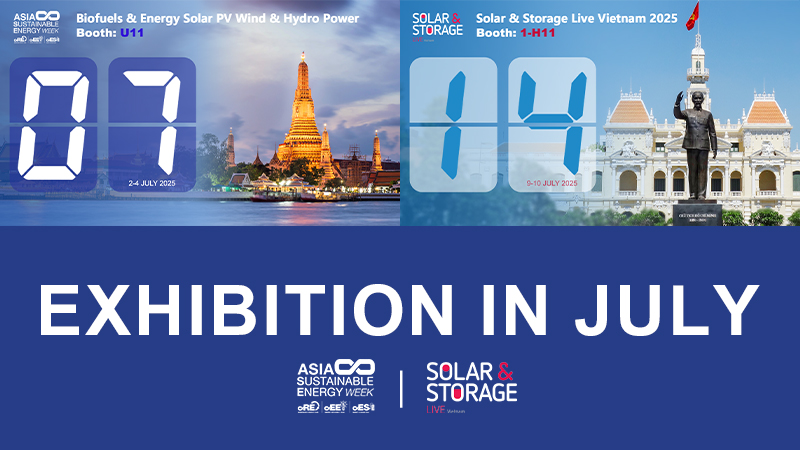Inverteris yra labai svarbi jūsų saulės energijos sistemos dalis, paverčianti saulės energiją elektra, kurią galite naudoti namuose. Išgirsite daugiausia apie dviejų tipų: hibridiniai keitikliai ir Įprasti saulės keitikliai.
Hibridiniai inverteriai Jie ne tik paverčia saulės šviesą elektra, bet ir valdo akumuliatorių energijos kaupimą. Tai leidžia naudoti saulės energiją dieną ar naktį, net ir elektros energijos tiekimo sutrikimų atveju. Standartiniai saulės keitikliai daugiausia siunčia energiją tiesiai į jūsų namus arba tinklą.
Skaitykite toliau ir sužinokite, kuris iš jų yra protingiausias pasirinkimas jūsų poreikiams.
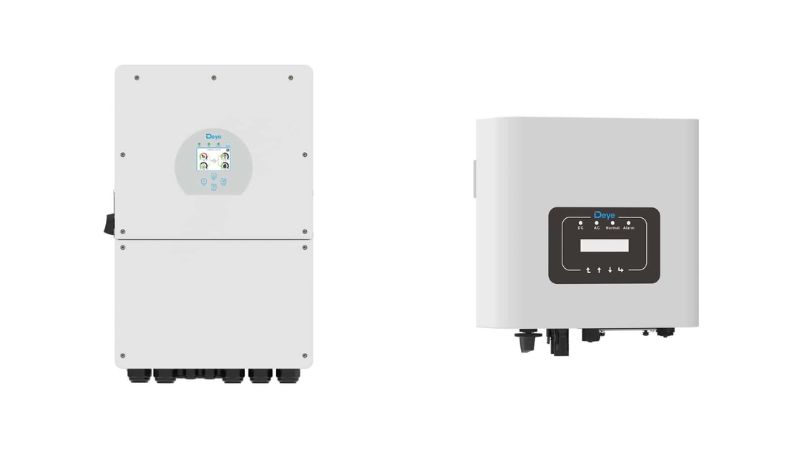
Hibridiniai keitikliai ir įprasti keitikliai: tiesioginis palyginimas
Pasirinkimas tarp hibridinio ir įprasto prie tinklo prijungto saulės keitiklio priklauso nuo kelių pagrindinių skirtumų, daugiausia susijusių su energijos kaupimu, energijos valdymu ir tinklo sutrikimų našumu.
| Funkcija | Įprastas keitiklis | Hibridinis keitiklis |
| Vietinė baterijos palaikymas | Nr | Taip (integruotas akumuliatoriaus valdymas ir įkrovimas) |
| Atsarginis maitinimas (tiekimo sutrikimas) | Išsijungia (dėl apsaugos nuo salų veikimo) | Gali tiekti (iš akumuliatoriaus ir nuolatinės saulės energijos) |
| Energijos valdymas | Bazinis (saulės energija į apkrovą / tinklą) | Išplėstinis (valdo saulės energiją, baterijas, tinklo srautą) |
| Maitinimo šaltinio tvarkymas | Pirmiausia saulės energija iš nuolatinės srovės į kintamąją srovę | Saulės, baterijų ir tinklo (dvipusis) |
| Pradinė sistemos kaina | Žemesnis | Didesnis (ypač kai yra baterijos) |
| Bendras sistemos sudėtingumas | Žemesnis | Didesnis (bet siūlo integruotą sprendimą) |
| Tinkamumas autonominiam naudojimui | Nr | Taip (su baterijomis ir tinkamai sukonfigūruota) |
| Didžiausias skutimosi pajėgumas | Nr | Taip (su akumuliatoriaus talpa) |
Kas yra hibridinis inverteris?
A hibridinis keitiklis, kartais vadinamas daugiarežimis keitiklis, yra pažangus įrenginys, sujungiantis standartinio saulės keitiklio ir akumuliatoriaus keitiklio funkcijas į vieną išmanų įrenginį. Pagrindinės jo galimybės:
- Nuolatinės elektros energijos iš saulės baterijų konvertavimas į kintamąją elektros energiją, skirtą naudoti namuose.
- Prijungto akumuliatorių bloko įkrovimo ir iškrovimo valdymas.
Kaip veikia hibridiniai saulės keitikliai
Hibridiniai keitikliai yra sukurti taip, kad išmaniai valdytų elektros energijos srautą iš kelių šaltinių: saulės baterijų, akumuliatorių kaupimo sistemos ir elektros tinklo. Štai tipinis veikimo srautas:
- Pirmenybę teikite savarankiškam vartojimui:Saulės energija pirmiausia naudojama patenkinti neatidėliotinus jūsų namų elektros energijos poreikius.
- Baterijos įkrovimas:Jei saulės energijos gamyba viršija namų ūkio poreikius, perteklinė energija nukreipiama į prijungtas baterijas.
- Tinklelio eksportas (neprivaloma):Kai baterijos visiškai įkraunamos, bet kokią papildomą saulės energijos perteklių galima eksportuoti į komunalinių paslaugų tinklą (jei tai leidžia vietos taisyklės ir jūsų komunalinių paslaugų įmonė).
- Akumuliatoriaus iškrovimas / atsarginė kopija:
- Silpno saulės spinduliavimo metu:Laikotarpiais, kai saulės šviesos mažai arba visai nėra (pvz., naktį, labai apsiniaukusiomis dienomis), keitiklis ima iš akumuliatorių sukauptą nuolatinę srovę, paverčia ją kintama srove ir tiekia ją jūsų namams.
- Tinklo sutrikimų metu:Nutrūkus elektros tiekimui, hibridinis keitiklis gali atsijungti nuo tinklo ir naudoti sukauptą akumuliatoriaus energiją, kad maitintų svarbiausias jūsų namų grandines.
Išmanusis valdymas: Daugumoje šiuolaikinių hibridinių keitiklių yra išmaniosios technologijos. Jie nuolat stebi:
- Saulės energijos gamyba
- Namų ūkių elektros energijos suvartojimas
- Baterijos įkrovimo būsena
- Tinklo prieinamumas
Šie realaus laiko duomenys leidžia keitiklio įrenginiui priimti išmanius sprendimus, kur nukreipti energiją, užtikrinant sklandų ir dažnai nepastebimą perėjimą tarp skirtingų energijos šaltinių (saulės energijos, akumuliatorių, tinklo).
Pagrindinės hibridinių keitiklių taikymo sritys ir privalumai
Hibridiniai keitikliai yra universalūs ir siūlo keletą privalumų, todėl jie tinka įvairioms reikmėms:
- Gyvenamųjų namų saulės energijos ir kaupimo sistemos:
- Pagrindinis naudojimas:Leidžia namų savininkams kaupti perteklinę saulės energiją vėlesniam naudojimui.
- Privalumas:Maksimaliai padidina saulės energijos suvartojimą savarankiškai, sumažina priklausomybę nuo elektros tinklo ir gali sumažinti sąskaitas už elektrą.
- Atsarginė galia:
- Svarbiausia savybė:Tiekia elektrą nurodytoms svarbiausioms jūsų namų grandinėms elektros tinklo gedimų metu, užtikrindamas energetinį saugumą.
- Autonominės sistemos:
- Esminis komponentas:Namams ar vietovėms, neprijungtoms prie elektros tinklo, hibridiniai keitikliai valdo energiją tarp saulės baterijų, akumuliatorių ir dažnai atsarginio generatoriaus.
- Didžiausias skutimas (apkrovos perkėlimas):
- Išlaidų taupymas:Vietovėse, kuriose elektros energijos tarifai nustatomi pagal naudojimo laiką (TOU), šie keitikliai gali kaupti energiją (iš saulės energijos arba pigesnės ne piko metu veikiančios elektros energijos) baterijose. Ši sukaupta energija vėliau naudojama brangiais piko laikotarpiais, taip sumažinant bendras elektros energijos sąnaudas.
- „Baterijomis paruoštas“ lankstumas:
- Daugelis hibridinių keitiklių yra sukurti taip, kad būtų paruošti naudoti su baterijomis. Tai reiškia, kad hibridinį keitiklį galite iš pradžių įrengti tik su saulės baterijomis, o vėliau pridėti suderinamą akumuliatorių, taip užtikrindami etapinį visapusiškos energijos sistemos kūrimo būdą.
Kas yra įprastas inverteris?
A standartinis saulės keitiklis, dažnai vadinamas tiesiog „įprastu keitikliu“ namų saulės energijos sistemose, techniškai yra prie tinklo prijungtas keitiklisJo pagrindinis tikslas yra:
- Konvertuoti Nuolatinė srovė (DC)jūsų saulės baterijų pagamintos elektros energijos.
- Į Kintamoji srovė (AC) Ši kintamosios srovės maitinimo įtampa gali:
- Įjunkite savo buitinius prietaisus.
- Būti eksportuojamam į komunalinį tinklą, jei jūsų sistema gamina energijos perteklių.
Kaip veikia įprasti (prie tinklo prijungti saulės) keitikliai
Šie keitikliai valdo tiesioginę energijos konversiją:
- Nuolatinės srovės į kintamąją srovę transformavimas:Jie ima nuolatinę srovę iš saulės baterijų.
- Tinklelio atitikimas:Jie konvertuoja šią nuolatinę srovę į kintamąją srovę, kuri tiksliai atitinka jūsų namų elektros tinklo įtampą ir dažnį (pvz., 120 V / 240 V esant 60 Hz arba 230 V esant 50 Hz).
- Grynos sinusinės bangos išvestis:Šiuolaikiniai įrenginiai naudoja tokias technologijas kaip Impulsų pločio moduliacija (PWM) sukurti „gryną sinusinę bangą“. Tai švari, stabili kintamosios srovės maitinimo forma, suderinama su visa buitine elektronika ir prietaisais.
Pagrindinės savybės ir apsaugos
- Apsauga nuo išsibarstymo salose:
- Funkcija:Tai yra itin svarbi saugos sistema. Jei sugenda elektros tinklas (nutumpiasi elektra), keitiklis automatiškai nustoja tiekti energiją.
- Paskirtis:Tai neleidžia saulės sistemai įjungti nutrūkusių elektros linijų ir užtikrina komunalinių paslaugų darbuotojų saugumą.
- Svarbi pastaba:Dėl šios priežasties standartiniai prie tinklo prijungti keitikliai neteikti atsarginio maitinimo šaltinio elektros tinklo sutrikimo metu.
- Kitos apsaugos priemonės:Įprasti saulės keitikliai taip pat turi apsaugos priemones nuo:
- Perkrova
- Trumpieji jungimai
- Per aukštos temperatūros sąlygos
- Konversijos efektyvumas:Jie paprastai yra 95% iki 98% efektyvus konvertuojant nuolatinę srovę į kintamąją.
Pagrindinis įprastų akumuliatorinių keitiklių (prijungtų prie tinklo) naudojimas:
- Prie tinklo prijungtos saulės energijos sistemos:Jų pagrindinis pritaikymas yra sistemose, kurių pagrindinis tikslas yra panaudoti pagamintą saulės energiją namų ūkių suvartojimui kompensuoti, o bet kokia perteklinė energija grąžinama į komunalinį tinklą (dažnai pagal grynojo matavimo arba tiekimo tarifų susitarimus).
- Ekonomiškai efektyvi saulės energijos konversija:Namų ūkiams, kurių pagrindinis tikslas yra sumažinti elektros energijos sąskaitas tiesiogiai naudojant saulės energiją ir eksportuojant ją į tinklą, be papildomo sudėtingumo ar išlaidų, susijusių su akumuliatorių kaupimu, įprasti saulės keitikliai yra efektyvus ir patikimas sprendimas.
Nors platesnė „įprastų keitiklių“ kategorija apima tokius tipus kaip stačiakampės bangos ir modifikuotos sinusinės bangos keitikliai (dažnai randami pagrindinėse autonominėse arba nešiojamose programose), Grynos sinusinės bangos keitikliai yra kokybiškų prie tinklo prijungtų namų saulės energijos įrenginių standartas.
Kuris inverteris geriausiai atitinka jūsų poreikius?
Tinkamo saulės keitiklio – hibridinio ar įprasto – pasirinkimas priklauso nuo jūsų energijos suvartojimo, biudžeto ir ateities planų.
Jūsų energijos poreikiai ir tikslai:
- Įprasti keitikliai:Jie puikiai tinka, jei jūsų elektros tinklo ryšys stabilus ir pagrindinis tikslas yra sumažinti elektros energijos sąskaitas naudojant saulės energiją dienos metu. Jie tinka, jei atsarginė energija nėra didelis rūpestis.
- Hibridiniai keitikliai:Jie geriau tinka, jei naudojate daug energijos, ypač vakarais, gyvenate ten, kur elektros tinklas nepatikimas arba elektros energijos tiekimo sutrikimai yra dažni, arba jei norite maksimaliai išnaudoti savo saulės energiją ir turėti atsarginę energijos šaltinį.
Sąnaudų veiksniai:
- Įprasti saulės keitikliai:Pats inverterinis blokas kainuoja mažiau, todėl pradinė investicija į saulės energiją yra mažesnė.
- Hibridiniai keitikliai:Inverteris yra brangesnis, o akumuliatorių pridėjimas žymiai padidina bendras išlaidas. Tačiau hibridinės sistemos gali pasiūlyti didesnę ilgalaikę vertę, dar labiau sumažindamos sąskaitas, nes naudojama daugiau nuosavos saulės energijos, užtikrinama atsarginė energija (tai gali padėti sutaupyti atskiro generatoriaus pirkimo) ir potencialiai pasinaudojant laiko atžvilgiu taikomomis elektros energijos kainomis.
- Atminkite:Visada patikrinkite, ar nėra mokesčių lengvatų, nuolaidų ar dotacijų, nes jos gali sumažinti bet kurios sistemos grynąsias sąnaudas.
Jūsų sistemos ateities užtikrinimas:
- Energetikos tendencijos keičiasi. Hibridiniai inverteriaisiūlo daugiau lankstumo prisitaikyti. „Baterijomis paruošti“ modeliai leidžia dabar įsirengti saulės energiją, o baterijas pridėti vėliau. Jie taip pat geriau tinka išmaniųjų namų sistemoms.
- Įprasti saulės keitikliaituri mažiau integruotų energijos kaupimo ar pažangaus energijos valdymo įrenginių diegimo galimybių vėliau be didelių sistemos pakeitimų ar pakeitimo.
Teisingas pasirinkimas su „Deye“ inverteriais
Pasirinkimas tarp įprasto ir hibridinio keitiklio priklauso nuo jūsų namų energijos suvartojimo, biudžeto ir poreikio turėti atsarginį energijos šaltinį. „Deye“ siūlo abu tipus, kad atitiktų jūsų konkrečią situaciją.
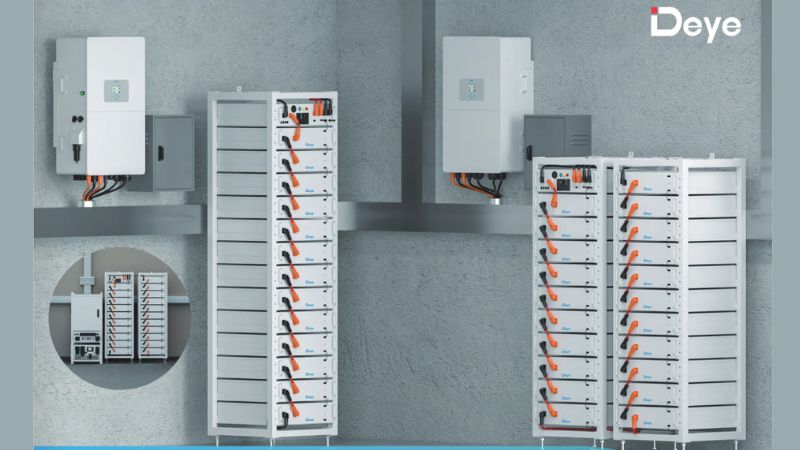
Jei norite sutaupyti sąskaitų naudodami tiesioginę saulės energiją (įprastus inverterius): Deye įprastas (prijungtas prie tinklo) keitiklis puikiai tinka, jei jūsų pagrindinis tikslas yra sumažinti elektros energijos sąskaitas naudojant saulės energiją dienos metu, o tinklo energija yra patikima.
- Tokie modeliai kaip SUN-(1-4)K-G04P1-EU-AM1(vienfaziams namams) arba SUN-10/12/15K-G05-LV (didesniems namams) efektyviai konvertuoja saulės energiją į tiesioginį naudojimą arba siunčia ją į tinklą.
- Jie yra ekonomiški ir turi saugos funkcijas bei išmaniojo stebėjimo parinktis.
Jei norite energetinės nepriklausomybės ir atsarginio maitinimo (hibridiniai keitikliai): Deye hibridinis keitiklis geriau, jei norite kaupti saulės energiją, kurią galėtumėte naudoti bet kuriuo metu (vakarais, elektros energijos tiekimo sutrikimų atveju), jums reikia atsarginio maitinimo šaltinio arba norite labiau kontroliuoti savo energiją.
- The SUN-12/14/16K-SG01LP1-EUHibridinė serija yra geras pavyzdys. Ji veikia su baterijomis, suteikia atsarginį energijos šaltinį, gali būti prijungta prie generatorių ir leidžia vėliau išplėsti sistemą.
- Ypatybės: didelė įkrovimo galia, išmanus akumuliatoriaus valdymas ir patogus jutiklinis ekranas.
- Daugelis „Deye“ hibridų yra „paruošti naudoti su baterijomis“, todėl galite pridėti baterijas vėliau, jei pradėsite tik nuo saulės baterijų.
Kodėl verta rinktis Deye? „Deye“ keitikliai yra žinomi dėl:
- Didelis efektyvumas:Išgaukite maksimalią galią iš savo plokščių.
- Patikimumas:Sukurtas ilgam tarnavimo laikui su stipriomis saugos apsaugomis.
- Tvirtas dizainas:Sukurta atlaikyti įvairias oro sąlygas (pvz., IP65 apsaugos klasė).
- Universalumas:Sprendimai nuo mažų namų iki didesnių komercinių poreikių, pavyzdžiui, galingi SUN-120/125/130/135/136K-G01P3-EU-AM8 arba SUN-M130/160/180/200/220G4-EU-Q0.
Ženkite kitą žingsnį su Deye Norėdami išsirinkti geriausią „Deye“ keitiklį:
- Peržiūrėkite „Deye“ asortimentą:Visus modelius galite peržiūrėti „Deye“ svetainėje.
- Gaukite ekspertų patarimų:Norėdami rasti idealiai tinkantį variantą, pasitarkite su „Deye“ specialistais arba vietiniu montuotoju.
- Užklausos dėl kainos:Lengvai paklauskite kainos ČIA.
Rinkitės „Deye“, jei norite išmanios, patikimos ir tvarios energijos ateities savo namams.
